Well, they are shifting and making vaccines and antibodies using plants now and not animals (mostly using tobacco plants, in an odd twist of fate). It is far cheaper, and a lot faster. Currently Ebola ZMapp antibodies are being made in Kentucky in tobacco related plants on a fast track through the CDC/FDA.
Navigation
Install the app
How to install the app on iOS
How To Use Progressive Web App aka PWA On 420 Magazine Forum
Note: This feature may not be available in some browsers.
More options
You are using an out of date browser. It may not display this or other websites correctly.
You should upgrade or use an alternative browser.
You should upgrade or use an alternative browser.
Micropropagation - Plant Tissue Culture
- Thread starter electro gypsy
- Start date
Well, this is going to be the most interesting adventure, fueled wonderfully by the music you so thoughtfully left for me to find.
You have some amazing home appliances, I'll give you that. Love the passion you bring to the search. You had me with the first post. If you notice me being absent and you have excitement going on over here you have my permission to find me and tug my hair, ok? I don't want to miss this, but you know how rediculously over-subbed I am. Although, my gypsy companion, you seem to have become a priority in my world, so maybe that won't be a concern after all.

It's impossible to listen to this music and be still at all. Typing to the rhythm is a trip! Haha!
You have some amazing home appliances, I'll give you that. Love the passion you bring to the search. You had me with the first post. If you notice me being absent and you have excitement going on over here you have my permission to find me and tug my hair, ok? I don't want to miss this, but you know how rediculously over-subbed I am. Although, my gypsy companion, you seem to have become a priority in my world, so maybe that won't be a concern after all.


It's impossible to listen to this music and be still at all. Typing to the rhythm is a trip! Haha!
- Thread starter
- #24
electro gypsy
New Member
Finally! Ugh what week lol.
The culture jars are now inoculated. The sample was taken from an OG Kush mother and kept in a jar of ph balanced water and Superthrive outside of the box. The box was lightly sprayed inside with bleach water and left to sit while showering.
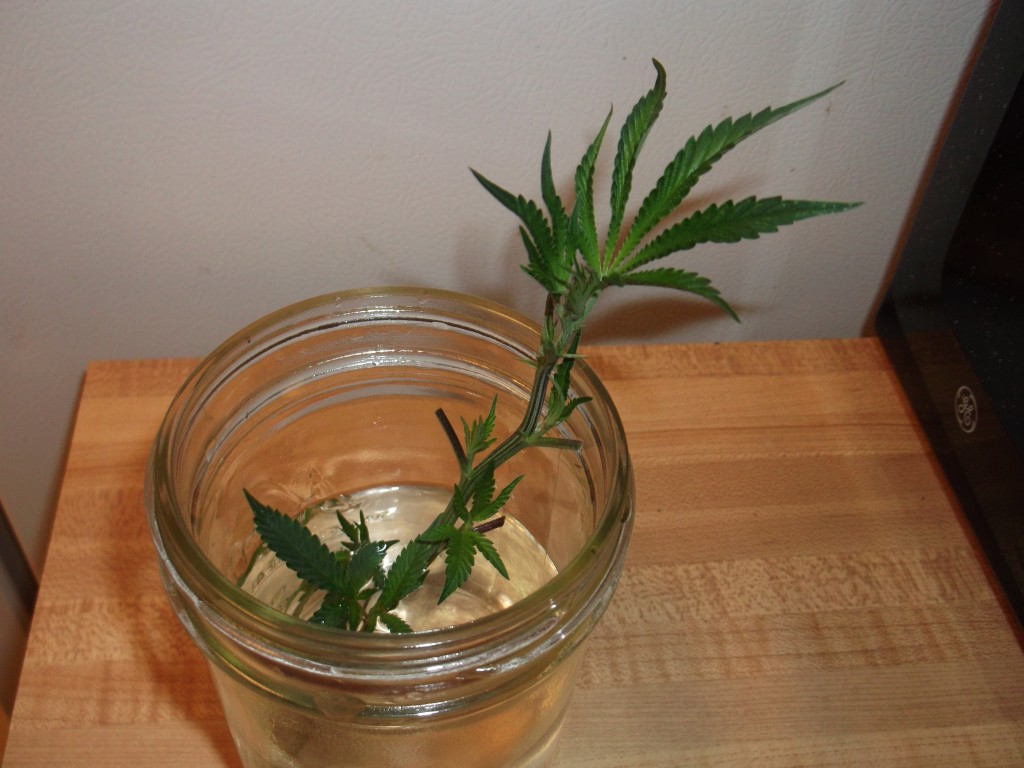
Then the hand holes were slit and the access door sealed with masking tape. Once my hands were inside the box everything is done quickly and smoothly. Disturbing the air inside the box and leaving culture medium exposed as little as possible. Every surface was cleaned with 99% alc. just prior to handling. Each tissue sample was soaked in Hydrogen Peroxide for approximately 20 seconds and shaken to remove excess before placing on the culture medium. 4 node sections and 1 forming leaf section were used for this experiment. From what I've read any part of the plant can be used. In some cases even root material, but the nodes, forming bud tips and leaf tips seem to have the best results because the new cells are still dividing.
View of SAB from right side..
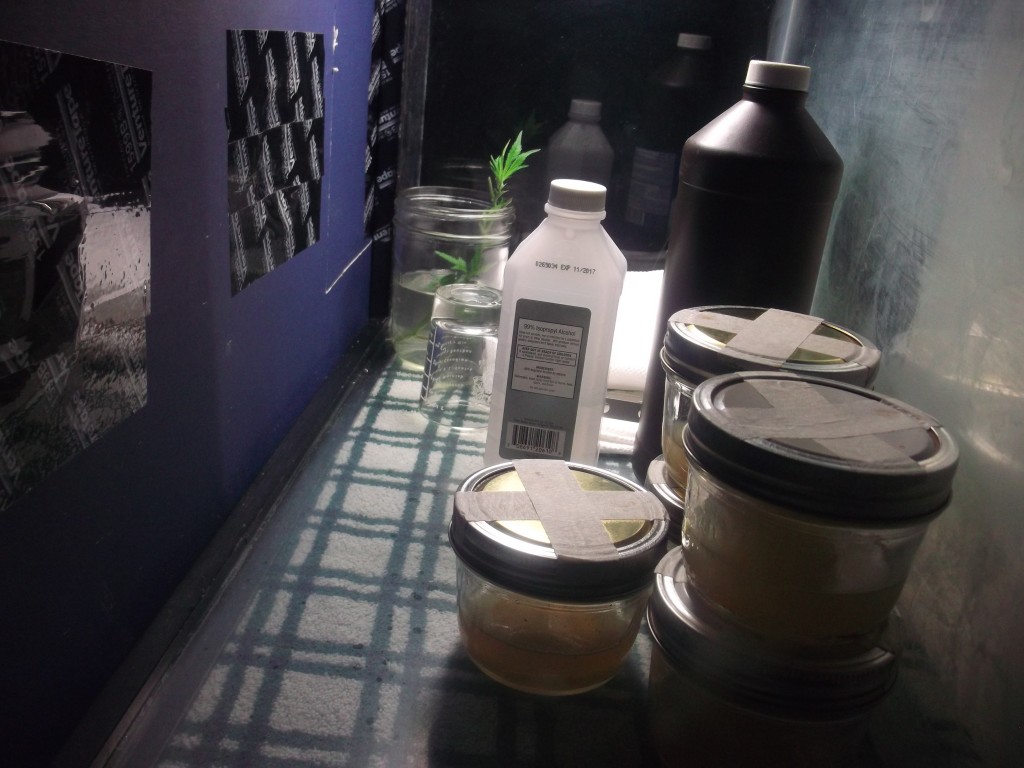
Left side..
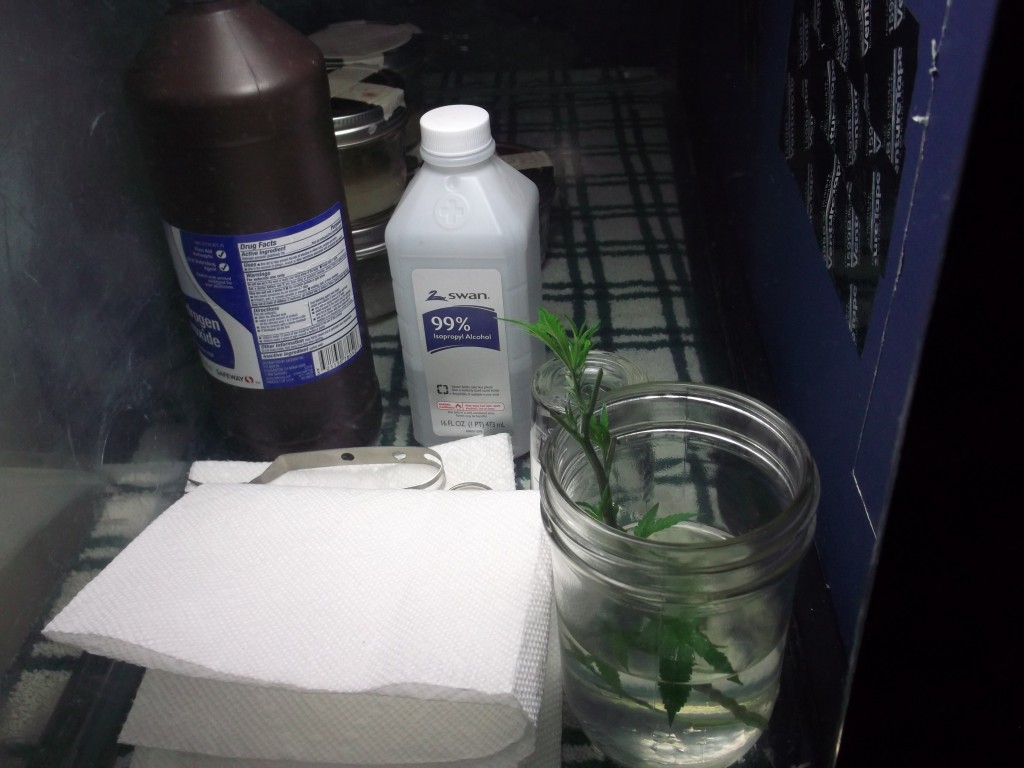
and our finished cultures..
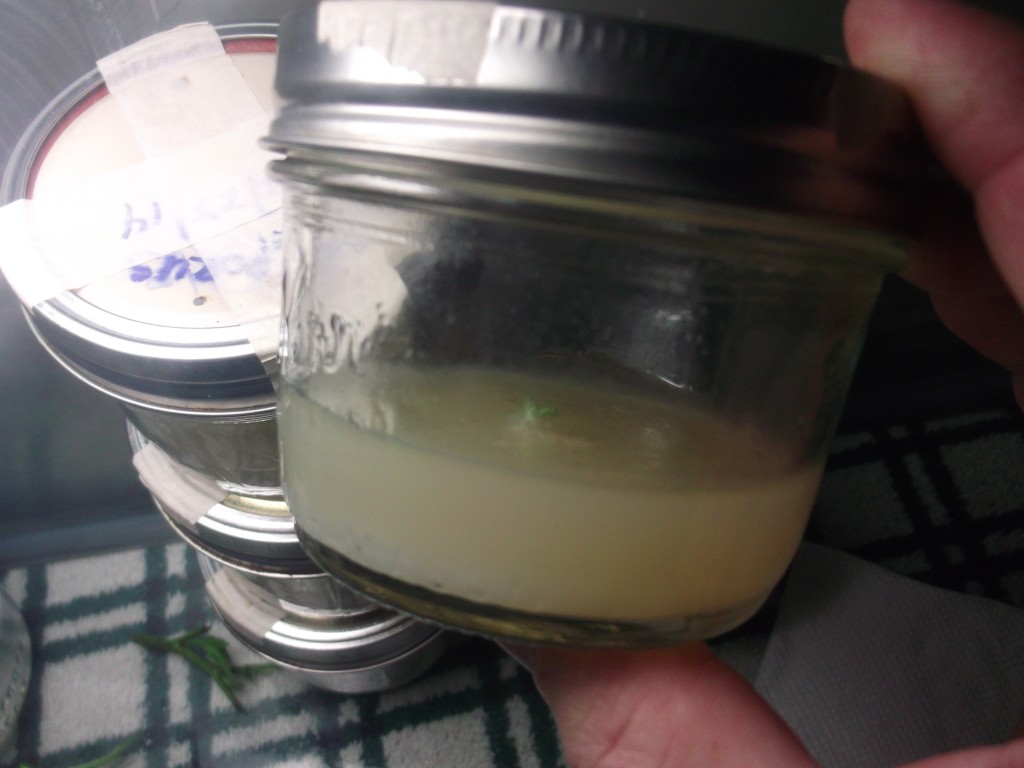
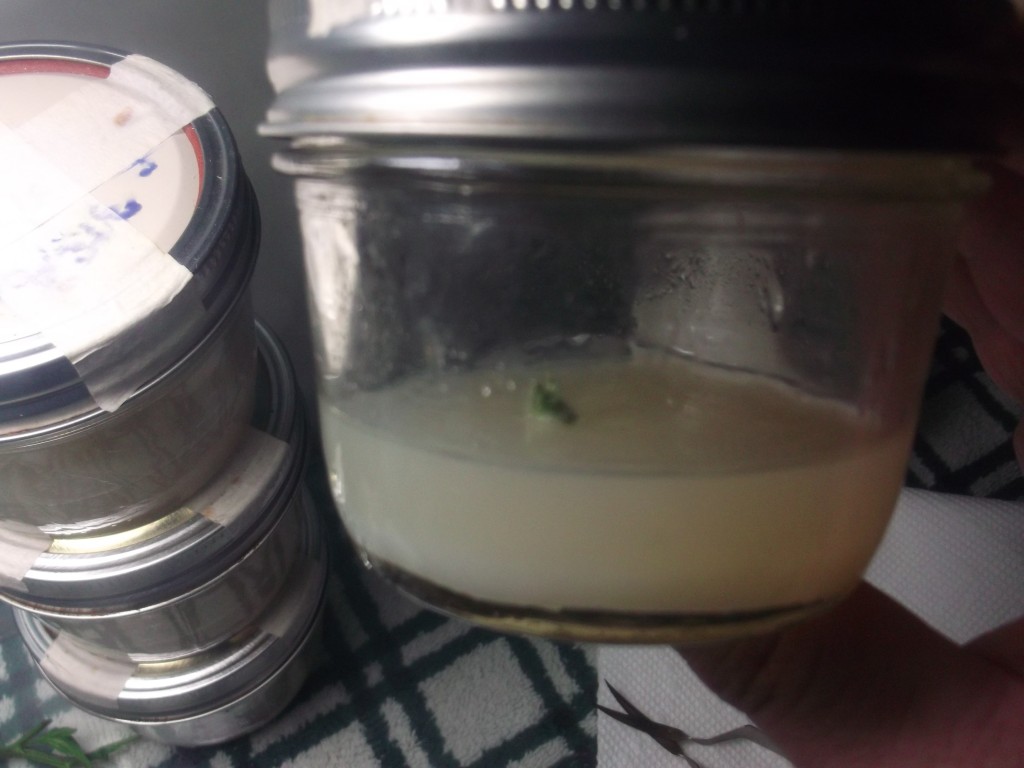
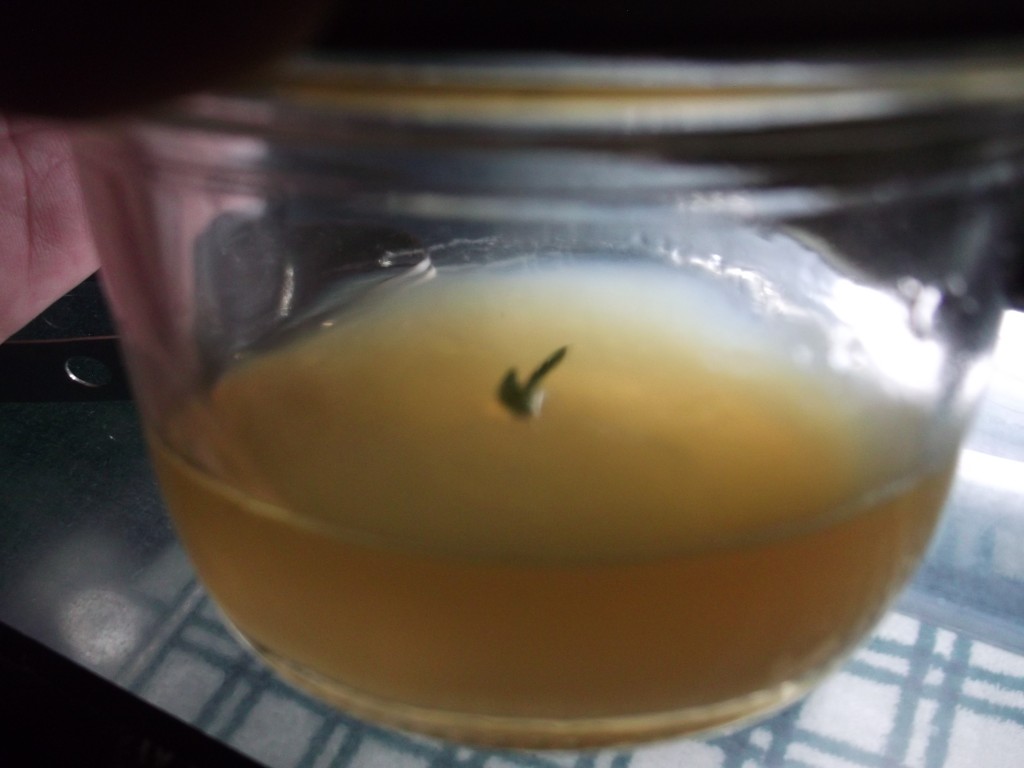
Looks like I'll have to get creative and make a rack lol. The only drawback to these jars is they do not have clear lids. I think we'll be ok slanting everything though.
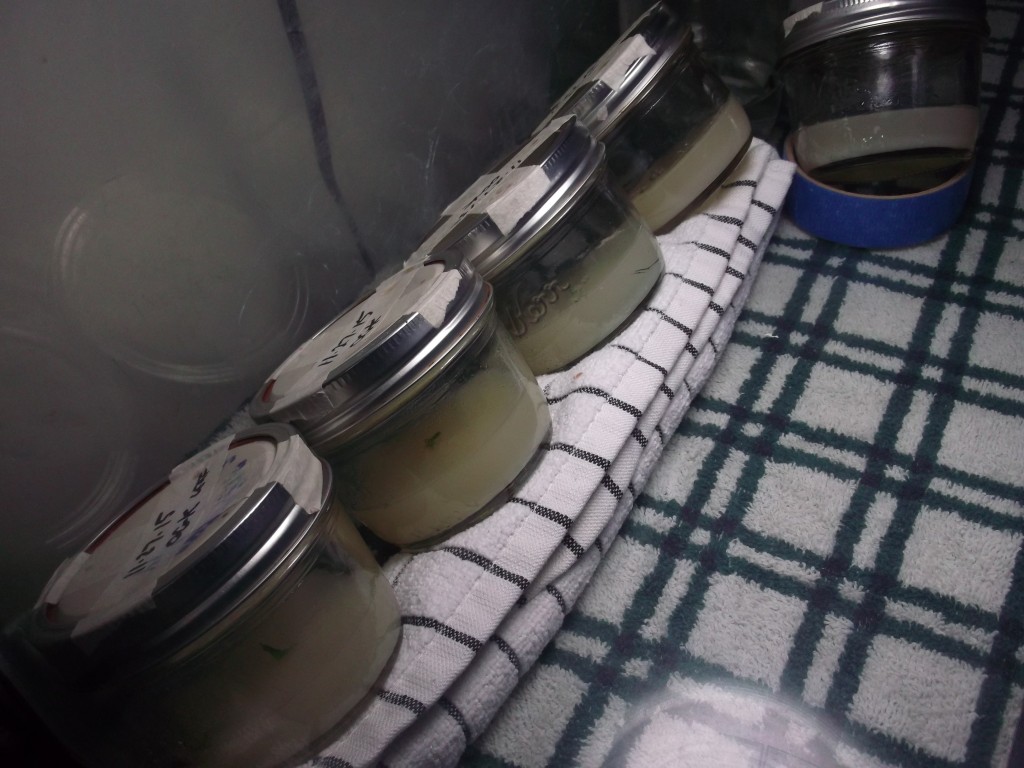
The culture jars are now inoculated. The sample was taken from an OG Kush mother and kept in a jar of ph balanced water and Superthrive outside of the box. The box was lightly sprayed inside with bleach water and left to sit while showering.
Then the hand holes were slit and the access door sealed with masking tape. Once my hands were inside the box everything is done quickly and smoothly. Disturbing the air inside the box and leaving culture medium exposed as little as possible. Every surface was cleaned with 99% alc. just prior to handling. Each tissue sample was soaked in Hydrogen Peroxide for approximately 20 seconds and shaken to remove excess before placing on the culture medium. 4 node sections and 1 forming leaf section were used for this experiment. From what I've read any part of the plant can be used. In some cases even root material, but the nodes, forming bud tips and leaf tips seem to have the best results because the new cells are still dividing.
View of SAB from right side..
Left side..
and our finished cultures..
Looks like I'll have to get creative and make a rack lol. The only drawback to these jars is they do not have clear lids. I think we'll be ok slanting everything though.
DankWolf907
New Member

Cultures are jarred. Good work my gypsy friend.
LOL! We were posting at the same time.
On to the second try. Life's one big science experiment.
LOL! We were posting at the same time.
On to the second try. Life's one big science experiment.
- Thread starter
- #27
electro gypsy
New Member
haha! I've been meaning to update this for about a week. 
So we successfully cultured a beautiful yeast. Also a few bacterial spots from the air, but the yeast came from the plant tissue itself. I'll try and snap a pic tonight so that I can show you how I know these things lol, but essentially the yeast came from fairly deep inside the plant tissue. This means a 20 second dip in the peroxide is no where near enough. It also means that at least one of my girls, likely all have a yeast infection. *insert deep deep thought music here
It just leads to even more fascinating implications lol. Something i'll definitely be researching soon.
At any rate, I wouldn't call it a failure as much a lesson. The good news is that the only thing that seems to have affected the tissue is the contamination. The largest of the samples actually began to grow a formation that may have been the beginnings of a leaf before the invader killed it.
I'll make another round of cultures sometime this week or weekend!
Much love!

So we successfully cultured a beautiful yeast. Also a few bacterial spots from the air, but the yeast came from the plant tissue itself. I'll try and snap a pic tonight so that I can show you how I know these things lol, but essentially the yeast came from fairly deep inside the plant tissue. This means a 20 second dip in the peroxide is no where near enough. It also means that at least one of my girls, likely all have a yeast infection. *insert deep deep thought music here
It just leads to even more fascinating implications lol. Something i'll definitely be researching soon.
At any rate, I wouldn't call it a failure as much a lesson. The good news is that the only thing that seems to have affected the tissue is the contamination. The largest of the samples actually began to grow a formation that may have been the beginnings of a leaf before the invader killed it.
I'll make another round of cultures sometime this week or weekend!
Much love!

- Thread starter
- #28
electro gypsy
New Member
Cultures are jarred. Good work my gypsy friend.
Hiya Sue!

These are some of the same jars I use in my Mycology hobby lol. The tape on the lids is covering injection holes. Otherwise it would not be needed. The half pint jars are of a design called the PF Tek in the fungal places of the internet. They double up nicely for culturing.

DankWolf907
New Member
Seems rather odd that ur plants would have a yeast infection..
Or is it.. Is this your first experiment like so? Is yeast necessarily a bad thing in plants? ..the ladies are still growing, right? How does one rid the plant of yeast?
And the peroxide bath... I dont see how 20mins would make a difference over 20seconds. If the yeast, or whatever, is way up inside the shaft of the stalk... The peroxide is only hitting the outside casing..
Or is it.. Is this your first experiment like so? Is yeast necessarily a bad thing in plants? ..the ladies are still growing, right? How does one rid the plant of yeast?
And the peroxide bath... I dont see how 20mins would make a difference over 20seconds. If the yeast, or whatever, is way up inside the shaft of the stalk... The peroxide is only hitting the outside casing..
- Thread starter
- #30
electro gypsy
New Member
Seems rather odd that ur plants would have a yeast infection..
Or is it.. Is this your first experiment like so? Is yeast necessarily a bad thing in plants? ..the ladies are still growing, right? How does one rid the plant of yeast?
And the peroxide bath... I dont see how 20mins would make a difference over 20seconds. If the yeast, or whatever, is way up inside the shaft of the stalk... The peroxide is only hitting the outside casing..
You'd be shocked at just how much weird stuff lives in the upper reaches of most cellular tissue. Yeast is extremely common. It's everywhere actually. In plants, in our skin, our intestinal tracts.. an amazingly diverse life form. I doubt it bothers our plants.. at least noticeably, but it brings up a good point. What exactly does it do? Typically 20 seconds in peroxide is enough to kill yeast and spores/endospores with soft tissues like mushrooms. I thought it might be a bit short for plant tissue, but it was the same time I used a few years ago when trying this. Back then it was a very late bacteria bloom that got them.. or me just slacking and not moving them to rooting media quick enough. There is no perfect clean when culturing. The best we can do is hope we get it clean enough to outrun any lurking invaders. If dividing cells reach the food supply before the contaminant there is a good chance for survival.
I'm still confident we can do this with a few adjustments.. and possibly many more to come lol.
- Thread starter
- #31
electro gypsy
New Member
OH! and a side note.. I left a small piece of the tissue in the solution that our volunteer was in. Just to see what would happen. It's still alive lol. It has been accompanied by some green algae but there it sits.
DankWolf907
New Member
So, uve prompted some digging. +rep
Not sure if or how this helps you, but certainly gives me another study for my den.
ABSTRACT
It has been previously demonstrated that dicotyledonous plants perform rhizophagy, a process in which live microbial cells are engulfed by root cells and digested to acquire the nutrients from the microbes. Here we tested the hypothesis that rhizophagy is a mechanism of nutrient acquisition that is not restricted to dicotyledonous plants. We report that the monocotyledonous species sugarcane (Saccharum officinarum x spontaneum), grown in controlled axenic conditions, incorporated yeast cells into root cells. This suggests that rhizophagy is an evolutionarily conserved trait that predates the divergence of dicot and monocot species. To explore the potential relevance and practical application of rhizophagy, we investigated brewers' yeast (Saccharomyces cerevisiae), a waste product of the brewing industry, for its role as biofertilizer. The addition of live or dead yeast to fertilized soil substantially increased the nitrogen (N) and phosphorus (P) content of roots and shoots of tomato (Solanum lycopersicum) and young sugarcane plants. Yeast addition to soil also increased the root-to-shoot ratio in both species and induced species-specific morphological changes that included increased tillering in sugarcane and greater shoot biomass in tomato plants. These findings support the notion that brewers' yeast is a cost-effective biofertilizer that improves not only plant nutrition but also plant vigor during the early growth phase. It remains to be established which yeast-derived substances trigger the observed plant growth effects, and how rhizophagy contributes to plant nutrient acquisition.
[
Yeast as a Biofertilizer Alters Plant Growth and Morphology (PDF Download Available). Available from: Yeast as a Biofertilizer Alters Plant Growth and Morphology (PDF Download Available) [accessed Dec 14, 2015].
CULTURE experiments which we have carried out with peas have shown that yeast extract—prepared by heating yeast in water—stimulates to a remarkable extent the development of blossoms. In these experiments, the plants were grown either in sterile culture fluids (pH 6.5) or in quartz sand, watered with Hiltner’s nutriment solution. Nitrogen was supplied to the plants either in the form of nitrates or by inoculating the seed with active bacterial strains. When suitable amounts of yeast extract were used, the test plants started blooming 5–10 days earlier than controls (test-plants 20–25 days, controls about 30 days after sowing). The number of pods was invariably some 50 per cent greater when the plants were given yeast extract. Excessive amounts of yeast extract were found to cause deleterious effects. Work is in progress to find out which particular factor in yeast extract is responsible for the stimulating action. Particular attention will be paid to the question whether the factor which stimulates the growth and blooming of plants is identical with the factor stimulating the cell division of micro-organisms
Not sure if or how this helps you, but certainly gives me another study for my den.

- Thread starter
- #33
electro gypsy
New Member
Fascinating  I better go for a walk and digest.. that just started so many thought processes lol.
I better go for a walk and digest.. that just started so many thought processes lol.
Thanks man!
 I better go for a walk and digest.. that just started so many thought processes lol.
I better go for a walk and digest.. that just started so many thought processes lol. Thanks man!

DankWolf907
New Member
Id never have thunk yeast to be benefitial... Thanks to YoU! 

Not sure if or how this helps you, but certainly gives me another study for my den.
Makes sense, really. I guess the term for this is to have a mycelium-rich rhizosphere. Plants supply the fungus with sugars, and the fungi supply plants with water and minerals. I have been using localized mushroom spores from shooms that bloom on my property to inoculate my potting soils with. I use sterile media (half peat moss and half sand) to root my cuttings and sprout seeds in. Once they have their true leaves and/or are rooted, I transplant them into the potting soil mix. I had not thought of using brewers or bread yeasts to do this. I will have to try this spring.
I have read some abstracts about using rice rhizosphere microflora inoculated bread factory waste as a breeder for making hydrogen gas with (for using as alternative auto fuels). There is also some scant information on using a fungal biomass to protect young plants against antagonistic pathogens (diseases).
haha! I've been meaning to update this for about a week.
So we successfully cultured a beautiful yeast. Also a few bacterial spots from the air, but the yeast came from the plant tissue itself. I'll try and snap a pic tonight so that I can show you how I know these things lol, but essentially the yeast came from fairly deep inside the plant tissue.
What I have long suspected, really. Mound up a 3'x3' pile of leaves, water it and let it sit there for all of a day and it will start to cook/compost all by itself. No need for 'compost starter' or anything else. The same method used for sweat curing weed in Columbia to make it gold. Which also leads me to believe that plants collect fungus either intentionally for beneficial mycorrhizal association or unintentionally by exposure and infection. Obviously both I guess.
Your attempts to sterilize the cuttings reminds me of the experiments in grade school where you stick a stalk of celery into food coloring and it draws it up. The speed in that experiment is mainly due to capillary action with large xylem tubes in the celery though. I am not sure how fast Cannabis takes up solutions when cuttings are dipped in water. I have read that using hydrogen peroxide will inoculate cannabis cuttings and seeds against most pathogens. The soaking time seems to be all over the map though. I read in one place that rooting cannabis plants in 1% HP for 2 days was a good way to disinfect them. Another place said to water and mist them with 1% HP water for several weeks to keep them disease free. I use Rootone which has a fungicide in it and no HP for my cuttings.
- Thread starter
- #37
electro gypsy
New Member
I wasn't able to get a good pic of the yeast, but if you google yeast on agar there are plenty of good pics. I did manage to get a picture of another hitch hiker. This one also started at the cultured tissue and grew outward. An indicator that it was present in the tissue like the yeast. It's a species of Fusarium. Not sure which one.. but it is a soil/plant dweller.
Fusarium is a large genus of filamentous fungi, part of a group often referred to as hyphomycetes, widely distributed in soil and associated with plants. Most species are harmless saprobes, and are relatively abundant members of the soil microbial community. Some species produce mycotoxins in cereal crops that can affect human and animal health if they enter the food chain. The main toxins produced by these Fusarium species are fumonisins and trichothecenes.
The name of Fusarium comes from Latin fusus, meaning a spindle.
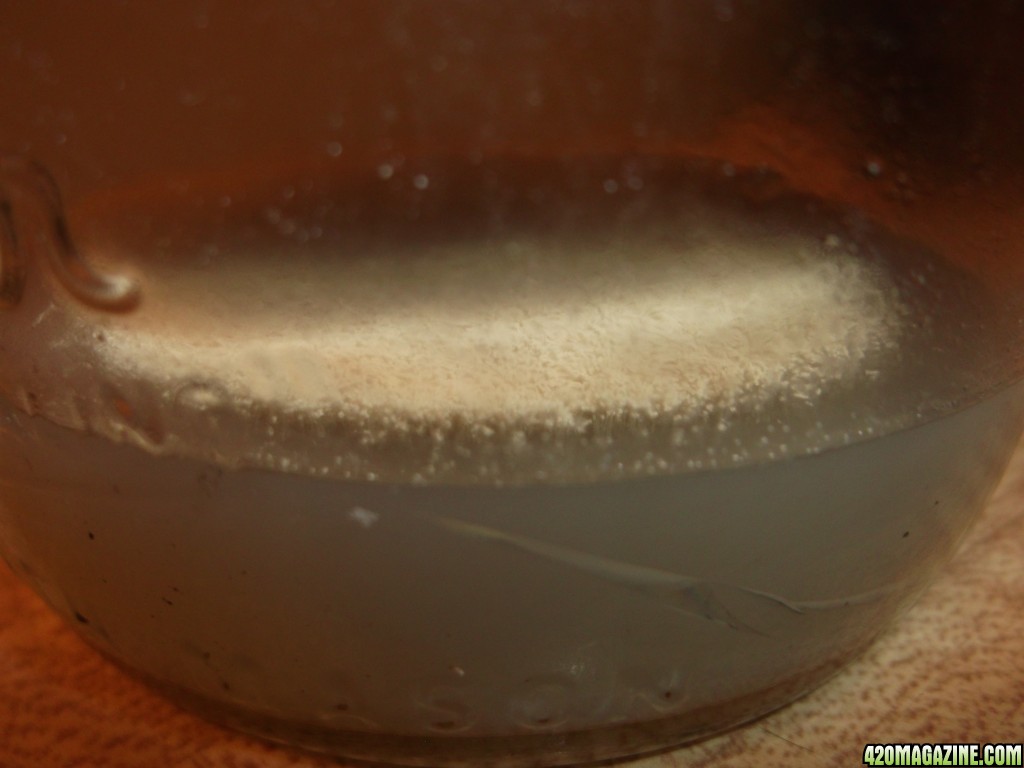
Fusarium is a large genus of filamentous fungi, part of a group often referred to as hyphomycetes, widely distributed in soil and associated with plants. Most species are harmless saprobes, and are relatively abundant members of the soil microbial community. Some species produce mycotoxins in cereal crops that can affect human and animal health if they enter the food chain. The main toxins produced by these Fusarium species are fumonisins and trichothecenes.
The name of Fusarium comes from Latin fusus, meaning a spindle.
featherdusta
New Member
Brilliant man i love it
- Thread starter
- #39
electro gypsy
New Member
Brilliant man i love it
Thanks!

i'll get back to it soon. worst time of year right now for contamination with all the spring cleaning. things will go a lot smoother once the rh drops.
Hashassinz
New Member
Omg these grow boxes, pressure cookers, sanitation and small jars reminds me of the days when some people grew shroomz like crazy idk who but just some people haha  GL hope it works out for u.
GL hope it works out for u.
 GL hope it works out for u.
GL hope it works out for u.
Similar threads
- Replies
- 2
- Views
- 920
- Replies
- 3
- Views
- 1K




